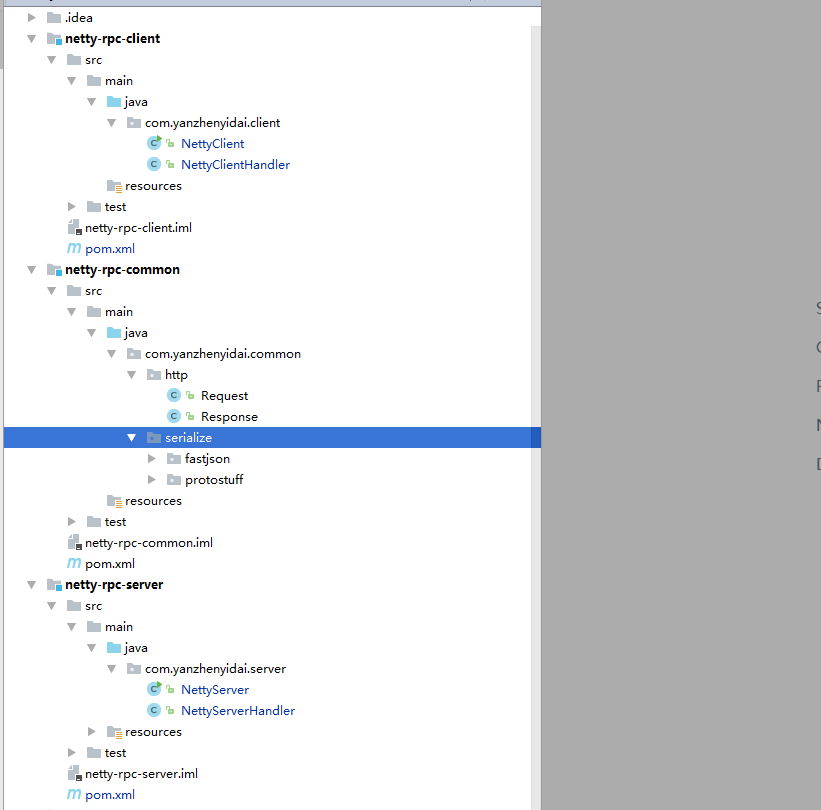使用Java搭建一个简单的Netty通信例子
看过dubbo源码的同学应该都清楚,使用dubbo协议的底层通信是使用的netty进行交互,而最近看了dubbo的Netty部分后,自己写了个简单的Netty通信例子。
本文源地址:
准备工程截图

模块详解
rpc-common
rpc-common作为各个模块都需使用的模块,工程中出现的是一些通信时请求的参数以及返回的参数,还有一些序列化的工具。
rpc-client
rpc-client中目前只是单单的一个NettyClient启动类。
rpc-server
rpc-client中目前也只是单单的一个NettyServer服务启动类。
需要的依赖
目前所有的依赖项都出现在 rpc-common 下的 pom.xml中。
<dependencies> <!-- Netty --> <dependency> <groupId>io.netty</groupId> <artifactId>netty-all</artifactId> <version>4.1.10.Final</version> </dependency> <dependency> <groupId>org.slf4j</groupId> <artifactId>slf4j-log4j12</artifactId> <version>1.7.25</version> </dependency> <!-- Protostuff --> <dependency> <groupId>com.dyuproject.protostuff</groupId> <artifactId>protostuff-core</artifactId> <version>1.0.9</version> </dependency> <dependency> <groupId>com.dyuproject.protostuff</groupId> <artifactId>protostuff-runtime</artifactId> <version>1.0.9</version> </dependency> <!-- Objenesis --> <dependency> <groupId>org.objenesis</groupId> <artifactId>objenesis</artifactId> <version>2.1</version> </dependency> <!-- fastjson --> <dependency> <groupId>com.alibaba</groupId> <artifactId>fastjson</artifactId> <version>1.2.38</version> </dependency> </dependencies> 实现首先我们在common中先定义本次的Request和Response的基类对象。
public class Request { private String requestId; private Object parameter; public String getRequestId() { return requestId; } public void setRequestId(String requestId) { this.requestId = requestId; } public Object getParameter() { return parameter; } public void setParameter(Object parameter) { this.parameter = parameter; } } public class Response { private String requestId; private Object result; public String getRequestId() { return requestId; } public void setRequestId(String requestId) { this.requestId = requestId; } public Object getResult() { return result; } public void setResult(Object result) { this.result = result; } }使用fastJson进行本次序列化
Netty对象的序列化转换很好懂, ByteToMessageDecoder 和 MessageToByteEncoder 分别只要继承它们,重写方法后,获取到Object和Byte,各自转换就OK。
不过如果是有要用到生产上的同学,建议不要使用 fastJson,因为它的漏洞补丁真的是太多了,可以使用google的 protostuff。
public class RpcDecoder extends ByteToMessageDecoder { // 目标对象类型进行解码 private Class<?> target; public RpcDecoder(Class target) { this.target = target; } @Override protected void decode(ChannelHandlerContext ctx, ByteBuf in, List<Object> out) throws Exception { if (in.readableBytes() < 4) { // 不够长度丢弃 return; } in.markReaderIndex(); // 标记一下当前的readIndex的位置 int dataLength = in.readInt(); // 读取传送过来的消息的长度。ByteBuf 的readInt()方法会让他的readIndex增加4 if (in.readableBytes() < dataLength) { // 读到的消息体长度如果小于我们传送过来的消息长度,则resetReaderIndex. 这个配合markReaderIndex使用的。把readIndex重置到mark的地方 in.resetReaderIndex(); return; } byte[] data = new byte[dataLength]; in.readBytes(data); Object obj = JSON.parseObject(data, target); // 将byte数据转化为我们需要的对象 out.add(obj); } } public class RpcEncoder extends MessageToByteEncoder { //目标对象类型进行编码 private Class<?> target; public RpcEncoder(Class target) { this.target = target; } @Override protected void encode(ChannelHandlerContext ctx, Object msg, ByteBuf out) throws Exception { if (target.isInstance(msg)) { byte[] data = JSON.toJSONBytes(msg); // 使用fastJson将对象转换为byte out.writeInt(data.length); // 先将消息长度写入,也就是消息头 out.writeBytes(data); // 消息体中包含我们要发送的数据 } } }NetyServer
public class NettyServerHandler extends ChannelInboundHandlerAdapter { @Override public void channelRead(ChannelHandlerContext ctx, Object msg) throws Exception { Request request = (Request) msg; System.out.println("Client Data:" + JSON.toJSONString(request)); Response response = new Response(); response.setRequestId(request.getRequestId()); response.setResult("Hello Client !"); // client接收到信息后主动关闭掉连接 ctx.writeAndFlush(response).addListener(ChannelFutureListener.CLOSE); } @Override public void channelReadComplete(ChannelHandlerContext ctx) throws Exception { ctx.flush(); } @Override public void exceptionCaught(ChannelHandlerContext ctx, Throwable cause) throws Exception { ctx.close(); } } public class NettyServer { private static final Logger logger = LoggerFactory.getLogger(NettyServer.class); private String ip; private int port; public NettyServer(String ip, int port) { this.ip = ip; this.port = port; } public void server() throws Exception { EventLoopGroup bossGroup = new NioEventLoopGroup(); EventLoopGroup workerGroup = new NioEventLoopGroup(); try { final ServerBootstrap serverBootstrap = new ServerBootstrap(); serverBootstrap.group(bossGroup, workerGroup) .channel(NioServerSocketChannel.class) .option(ChannelOption.SO_BACKLOG, 1024) .option(ChannelOption.SO_SNDBUF, 32 * 1024) .option(ChannelOption.SO_RCVBUF, 32 * 1024) .option(ChannelOption.SO_KEEPALIVE, true) .childHandler(new ChannelInitializer<SocketChannel>() { protected void initChannel(SocketChannel socketChannel) throws Exception { socketChannel.pipeline().addLast(new RpcDecoder(Request.class)) .addLast(new RpcEncoder(Response.class)) .addLast(new NettyServerHandler()); } }); serverBootstrap.childOption(ChannelOption.SO_KEEPALIVE, true); // 开启长连接 ChannelFuture future = serverBootstrap.bind(ip, port).sync(); // if (future.isSuccess()) { // // new Register().register("/yanzhenyidai/com.yanzhenyidai.server", ip + ":" + port); // } future.channel().closeFuture().sync(); } finally { bossGroup.shutdownGracefully(); workerGroup.shutdownGracefully(); } } public static void main(String[] args) throws Exception { new NettyServer("127.0.0.1", 20000).server(); } }关键名词:
EventLoopGroup
workerGroup
bossGroup
Server端的EventLoopGroup分为两个,一般workerGroup作为处理请求,bossGroup作为接收请求。
ChannelOption
SO_BACKLOG
SO_SNDBUF
SO_RCVBUF
SO_KEEPALIVE
以上四个常量作为TCP连接中的属性。
ctx.writeAndFlush(response).addListener(ChannelFutureListener.CLOSE);

